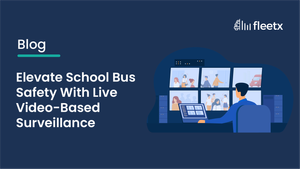
In the past decade, automation and enhanced safety have been prioritized at the forefront of numerous industries as a result of the integration of technology into daily life. School transportation is one area that is undergoing substantial advancements in technology. Amidst these technological advancements, video telematics is a remarkable innovation that has the potential to completely transform the way school buses function.
The World Health Organization estimates that traffic injuries are the primary cause of death for children and young adults aged 5 to 29 worldwide, which is concerning information. India has one of the highest rates of traffic accidents in the world, with over 150,000 deaths each year, and a lot of those deaths are children. This makes the situation even more urgent. These startling statistics demonstrate how urgently improved safety precautions in school transportation are needed.
In order to solve this urgent problem, Video telematics in school buses is not just a trend but also a requirement. Video telematics offers a comprehensive solution to increase operational efficiency and safety by guaranteeing driver accountability, improving overall fleet management, and offering real-time monitoring capabilities.
School buses are the major form of transportation for millions of students around the world, and therefore play an important role in ensuring the security of children and providing them with access to educational opportunities. These are eight strong reasons why video telematics is a vital component of school buses in India and around the world.
1. Improved safety measures for students
The key objective of any school transportation system is student safety. Real-time monitoring inside the bus is made possible by video telematics, which contributes to an increase in safety. Driver behavior monitoring guarantees that drivers follow safe driving procedures and discourage dangerous driving. Such monitoring is essential in areas such as India, where road safety is a major concern—evidenced by the country's 11% global share of road accident mortality.
2. Preventing Accidents
Video telematics, which incorporates intelligent driver aid technologies like forward collision alarms and lane departure warnings, is essential for preventing accidents. These devices warn drivers of possible dangers, assisting them in keeping their composure in difficult traffic circumstances that are common in crowded places.
3. Training and Accountability
Driver performance can be assessed using data from video telematics systems. This is important for carrying out training programs that work and making sure drivers follow the rules of the road and school regulations. To improve general safety and driving standards, video review can spot trends of harsh braking or quick acceleration and address these issues through focused training.
4. Effective Fleet Administration
The effective administration of a school bus fleet entails route optimization, adequate vehicle maintenance, and observance of environmental requirements. Video telematics with integration of fleet management system enables these activities by providing real-time monitoring. In addition to optimizing routes to save time and fuel, this also makes preventative maintenance possible, which lowers the chance of breakdowns and increases the longevity of vehicles.
5. Improved Communication
Particularly in emergency situations, the ability to send live footage from buses to emergency responders or school administration is required. This function makes sure that the right information is communicated right away, enabling prompt and appropriate actions. In India, where school routes may reach distant locations, this kind of technology is crucial for immediate crisis planning and communication.
6. Compliance and Legal Protection
An objective record of the events is provided by video telematics, which is essential for legal protection in the case of incidents or accidents. In the event of a disagreement, this video may be extremely helpful in clearing the names of drivers and educational institutions. Furthermore, video proof ensures compliance and helps to prevent potential legal complications by making it easier to follow the strict requirements on school bus operations set by the Supreme Court.
7. Mental Peace for Parents
It is only normal for parents to worry about the well-being of their children. These worries can be answered by video telematics, which has capabilities that let parents track their child's bus in real-time. With the use of applications that offer GPS tracking or live video feeds, parents can feel more secure about their children's safety and the dependability of the services that schools provide.
8. Ecologically Friendly Activities
Ultimately, the use of video telematics integrated with fleet management system makes school transportation operations more environmentally friendly. It assists in lowering pollutants and fuel consumption by streamlining routes and enhancing driver behavior.
Final Thoughts
Using video telematics in school buses is becoming more than simply an upgrade; it's a must. Modern school transportation systems must include it because of its vital safety features and operational efficiencies. In addition to providing for the immediate needs of sustainability, efficiency, and safety, this technology paves the way for further developments in student transportation. As a result, educational organizations all over the world—and particularly in challenging environments like India—are seeing the significant advantages of video telematics and seeing it as a necessary investment for the efficient and safe transportation of students.






